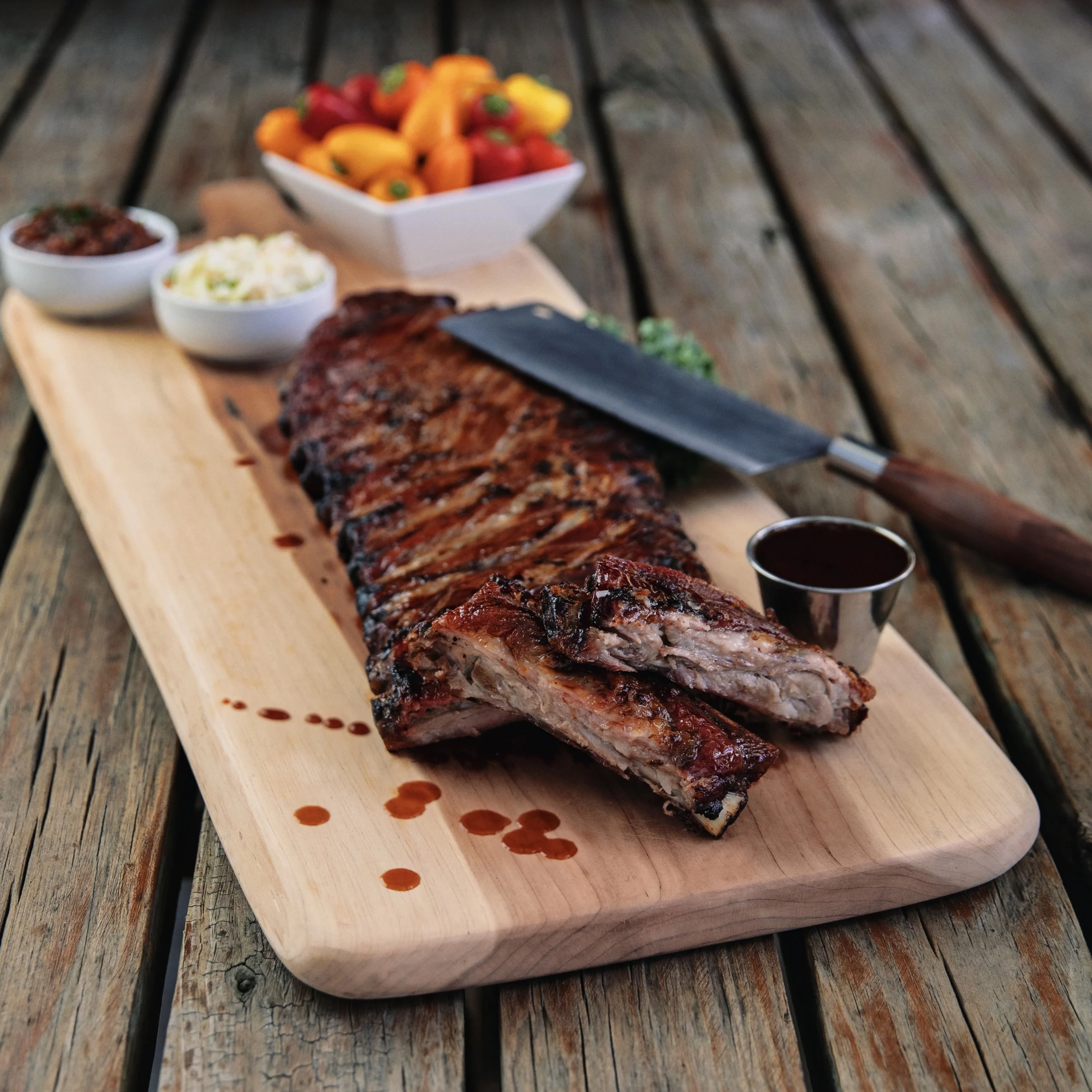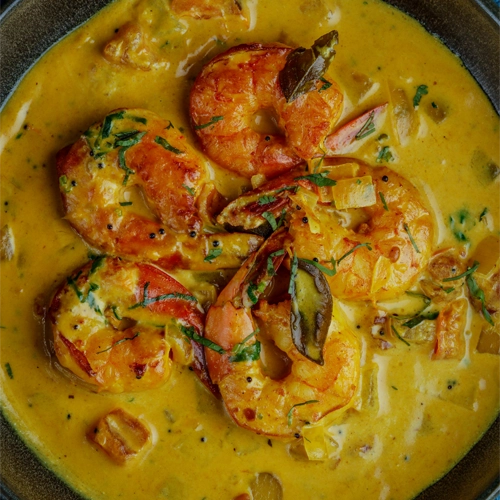by Katie Hendrick | May 27, 2016
Grove Stand: Goal Man to Soul Man
Trading in his hockey stick for a potato peeler at his uncle’s restaurant put Sarasota chef Steve Phelps on the path to scoring big in the culinary, environmental and philanthropic arenas
The setting sun casts an amber glow on the 78-year-old cracker cottage, where approximately 80 guests visit between sips of wine and bites of the day’s fresh catch (mangrove snapper) while James Brown, in the background, bids them to “get up offa that thing and shake” ‘til they feel better. It’s a gorgeous and joyful Tuesday night at Indigenous, a farm-to-table restaurant regarded as a bucket list experience for every foodie living in or visiting Sarasota.
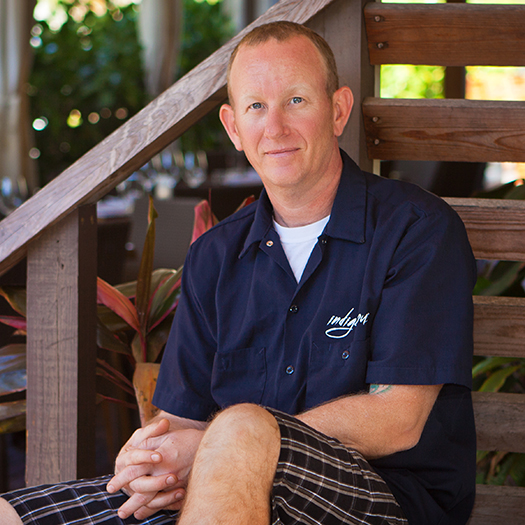
Chef Steve Phelps, the mastermind of Indigenous; Photograph by Kim Longstreet
Chef Steve Phelps, a two-time James Beard Award nominee, steps outside to greet diners on the porch. His deportment belies his culinary prestige. In lieu of crisp chef’s whites, he wears tennis shoes, cargo shorts, a Dickie’s short-sleeve black button-down embroidered with the Indigenous logo and an apron. There’s no toque hiding his buzzed strawberry blond hair.
As Phelps waves at familiar faces in the crowd, it’s impossible to miss the colorful tattoo snaking up his left forearm. It’s a tapestry of koi, gerbera daisies (his wife’s favorite flowers) and maple leaves. “I’m a maple syrup freak,” he explains. “I go through three gallons a week. It’s in a lot of the recipes on the menu.”
He asks a customer how she likes her Parmesan beignets and smoked cobia belly. “Phenomenal!” she says. Then the conversation drifts to that Florida-favorite topic: the weather. “Aren’t we lucky it turned out to be such a beautiful night?” Phelps says. From noon until about 5 p.m., a half hour before the doors opened, rain gushed over Sarasota. Phelps wraps weatherproof curtains around the porch during inclement weather, but they restrain the ambience considerably.
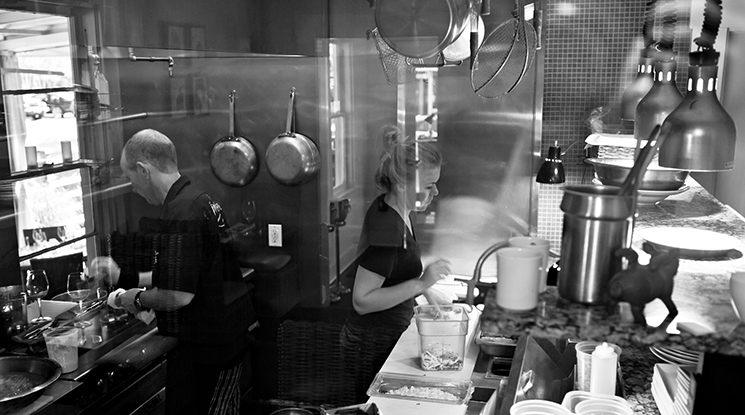
Photograph by Kim Longstreet
“My favorite hour is when day transitions to night,” he says. “Light streams through the windows and, if you look around, the walls seem to have a chameleon effect.” As time inches closer to twilight, the paint appears to go from aubergine to indigo, he explains. At the same time, the restaurant’s soundtrack starts to increase its tempo. “We treat the meal as a theatrical production,” he says. “There is always music playing and we pick it to match the mood of the restaurant.”
He starts with bands like Alabama Shakes and The Black Keys. As the night progresses, “the vibe gets more lounge-y, so we’ll play rock or blues—artists like Gary Clark Jr. or Medeski Martin & Wood. The last thing we play is always the Monophonics,” he says. “It gets guests ready to go home and keeps my staff motivated to finish strong.”
It’s been nearly five years since Phelps opened Indigenous, yet he still can’t quite believe this is his real life. Creating flavorful meals that nourish diners’ bodies and souls? “What an unbelievable privilege!” he says. He never dreamed the restaurant would reach capacity (140 diners a night) almost daily and, on weekends, routinely have a waiting list 50 to 75 parties deep. Nor did he envision himself living in Florida—or even working in a kitchen.
Growing up in Cleveland, Ohio, in the 1980s, Phelps played ice hockey all the time. He was good enough to make the team at Ohio State University, where he started his studies with the ultimate goal of becoming an orthopedic surgeon. “I’d broken almost everything—fingers, arms, wrists, shoulders, elbows and my nose—so I spent countless hours at the sports medicine department of the Cleveland Clinic, and I was really interested in fixing up athletes like me,” he says.
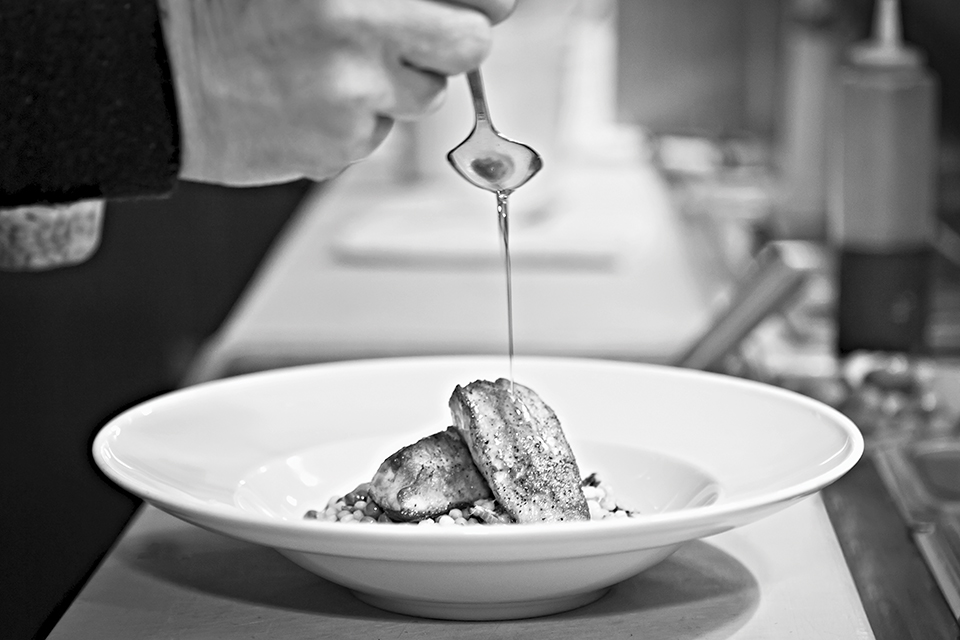
Pan-seared cobia with a wild mushroom gastrique sauce; Photograph by Kim Longstreet
But during his first year in Columbus, Phelps discovered two truths that would uproot his plans. “One, I was clearly too little to make it as a hockey player,” he says of his 5-foot-10-inch frame, roughly 6 inches shorter than many of the other guys who checked him on the ice. Furthermore, the medical world was even more competitive than the rink. “I remember hearing that 1,600 students applied to Ohio State’s medical school a year and only a quarter got in,” he says. Discouraged, he dropped out after his second semester.
To pay the bills while he contemplated his next move, Phelps returned to his high school gig: working in his uncle’s restaurant. When Phelps was 14, his uncle, a former military chef who’d had classical training in Germany and France, offered him a position as a dishwasher. Pleased to accrue some spending money, he stuck with the job, rising to more hands-on roles such as potato peeler and line cook. It was steady work, but it didn’t exactly inspire the teenage Phelps.
It took a long year after leaving Ohio State for his attitude to change about being back at the restaurant. A local reporter stopped in one day and asked to speak with the chef. “My uncle had been out for a while, so I told her all the things she ate were my creations for the next menu,” he says of the tasting he provided for her. She responded, “Well, you’re going to be a great gift to the culinary world one day.”
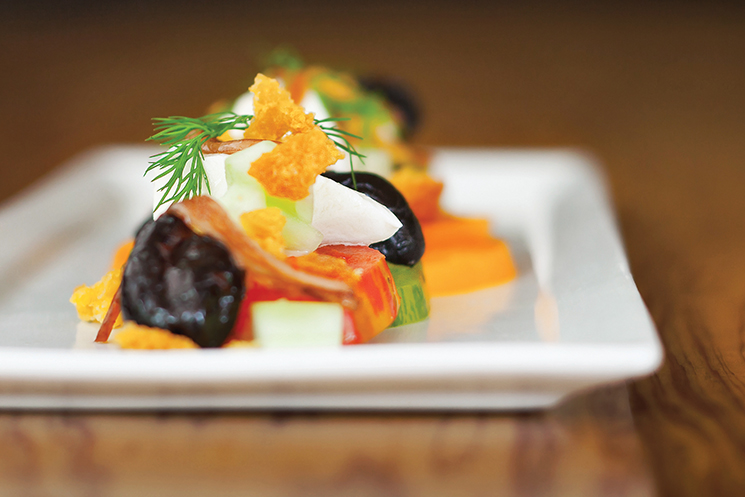
Panzanella salad; Photograph by Kim Longstreet
That feedback ignited in him a new passion. “Cooking went from something I could do, possibly for a living, to something I desperately wanted to make my vocation,” Phelps says. He zeroed in on his uncle’s techniques; checked out various culinary schools’ required reading lists, which he plowed through on his own; and practiced recipes “over and over again” at home. “Formal education’s not everything,” he says. “If you want something badly enough, you’ll study it yourself and put in the effort to be good at it.”
Soon Phelps was forging his own culinary reputation in Cleveland at Hyde Park Prime Steakhouse, where he worked his way up from pantry worker to head chef.
In 2001, after seven years at Hyde Park, Phelps was working at another Cleveland restaurant, Fat Cats, when his wife, Kim, a photographer, suggested the couple move to Sarasota, where she could hone her skills at the Ringling College of Art & Design. Phelps recalls his response: “That could be fun. I’m sick of scraping snow off my windshield. Let’s go for a year.”
Phelps took an instant liking to the Sunshine State. An avid fisherman, he took his boat out on the Gulf at the first opportunity. “It was like hearing the angels sing,” he says of the switch from freshwater to saltwater. About 20 times as many species live off Florida’s coasts than in the lakes of the Midwest, he says, “and you can eat almost all of them!”
While in awe of the Gulf’s bounty, Phelps didn’t think much of Sarasota’s seafood scene. “It seemed like all I could find in restaurants were scallops and fried shrimp baskets,” he says. “Where was the grouper, the cobia or the pompano? There were tons of local fish missing from menus.”
When Phelps interviewed for jobs, he would discuss his mission to learn more about Florida’s native species and introduce them to Sarasota diners. Over the course of a decade, he worked his way through five well-established restaurants. Meanwhile, he buddied up with fishmongers and boat captains, relationships that would have a profound impact on his career. Using their products, Phelps became more inventive with his seafood recipes; hearing their stories about foreign competition and the shady practices abroad, he became incensed.
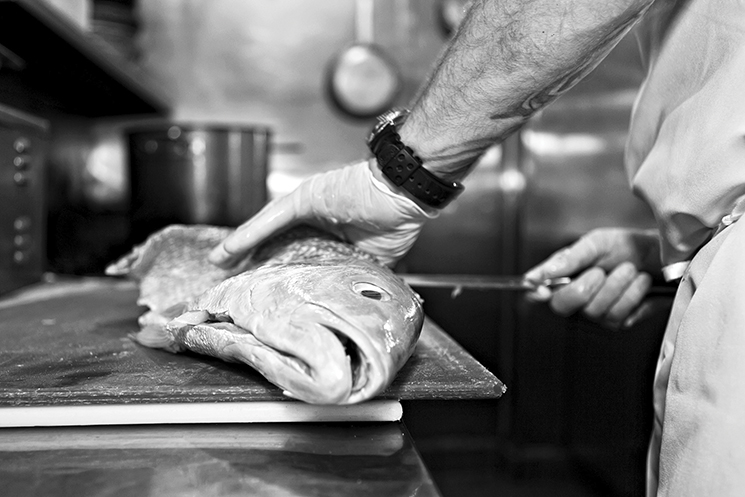
Phelps butchers an American red snapper; Photograph by Kim Longstreet
“More than 90 percent of the seafood served in U.S. restaurants came from another country,” he says, citing statistics from the Monterey Bay Aquarium’s Seafood Watch. “That’s depressing.”
The more Phelps researched, the more dirty facts he uncovered—swordfish that dangled on a line, dead for three days, before being reeled in; fish farms that used feed containing hormones or allowed runoff that damaged ecosystems; shrimp produced by slave labor in Thailand. “The problems run deep.”
In addition to a slew of ethical issues, “bad fishing processes” diminish the quality of the meat, he says. “There’s a big difference in taste between a freshly caught fish and one that’s been left unattended on a line for who knows how long.”
A conviction to promote sustainable seafood practices spurred Phelps to break off on his own, so he could have complete authority over the menu. When the cracker house in Sarasota’s artsy Towles Court community became available in 2011, Phelps couldn’t resist it. For starters, it had once been the Canvas Cafe, the site of a former job, “the one that put me on the map in Sarasota,” he says. Second, he liked the neighborhood’s density of small businesses, especially those with a creative bent, including hair salons, interior design studios and art galleries. Finally, the building’s architecture harkened to a time when Floridians personally grew, caught or hunted their own food.
Phelps furnished Indigenous with tables made of reclaimed cypress from a North Florida swamp and decorated it with artwork by Tim Jaeger, a Ringling College graduate. He planted an herb garden in the side yard. And he assembled a team of 15 workers who share his passion for food, wine and music. “I’m skeptical of anyone who doesn’t like music,” he says. “How can they work in silence? When the power goes out in a thunderstorm, our staff is more upset that the music stopped than the fact that the oven won’t turn on.”

Pan-seared Gulf amberjack with griddlecake, basil jalapeño purée and tomato jam, see our blog for recipe; Photograph Kim Longstreet
Phelps works on the line with his staff every day, making everything from scratch. “It’s like Groundhog Day,” he says. He limits the menu to 14 items, adhering to a philosophy of quality over quantity. “A small menu lets us execute everything perfectly,” he says. He changes the menu every three to four months, reflecting what’s in season. His fish options, however, fluctuate by the day, based on what his sources bring him. Some days, it’s red snapper; other days, it might be “trash fish,” species most commercial fishermen dismiss, such as porgy or hogfish. He’s even served lionfish, an invasive species wreaking havoc on Florida’s reefs. “We made it into a tartare,” he says. “It’s delicious!”
As a result of the James Beard nominations, Phelps has earned a higher soapbox to advance issues important to him. The Monterey Bay Aquarium’s Seafood Watch Program invited him to tour its research station in California and to become an ambassador of sustainable seafood. Chefs Collaborative, an organization that promotes education within the food industry, appointed him as a local leader.
In addition to educating people about where their food comes from, Phelps is active in programs that help feed the less fortunate. When he heard the nonprofit group Share Our Strength’s sobering figure that 13 million children in the U.S. go to bed hungry, he knew he needed to do something to lower that number. “It broke my heart,” he says. Locally, he participates in Chefs Move to Schools, a program that pairs professional chefs with students to develop a tasty and nutritious—but also low-cost—meal for the school menu. “Schools have incredibly low budgets to put together healthy meals for kids,” he says. He spent quality time learning what kids like (pizza and Chinese food), working with them in the school garden, teaching them about nutrition, and ultimately coming up with a stir fry dish consisting of brown rice, vegetables, eggs and garbanzo beans—a low-sodium, high-fiber and high-protein version of the Chinese food they knew and loved.
All of the above activities require significant commitments that go beyond writing a check. “It’s tough stepping away from your kitchen,” he says. “But time is necessary to make a difference. My status gives me special opportunities, so I need to take advantage of that.”
Phelps’ hectic schedule eliminates “almost all” social activities, he says, and allows scant time for sleep. He’s at the restaurant until the staff cleans and locks up, often just short of midnight, and then, when he gets home, he’s too wired to go to bed “for at least an hour.” His days start whenever Nyla, his Rhodesian ridgeback and Catahoula mix, dictates—typically around 6 a.m. “Once she’s up, I’m up,” he says. “The wheels in my head start turning. I’m thinking about food and I can’t stop.”
“It’s pretty exhausting if I stop and think about it,” he continues. “But when you do something you really love, you get this glowing energy that drives you to get up and do it every day.”
Rain or shine.
See our blog for recipes from Indigenous.

